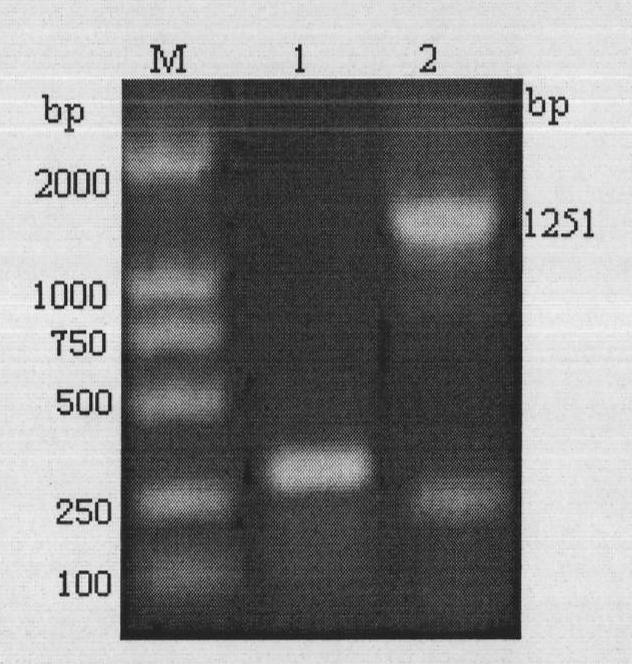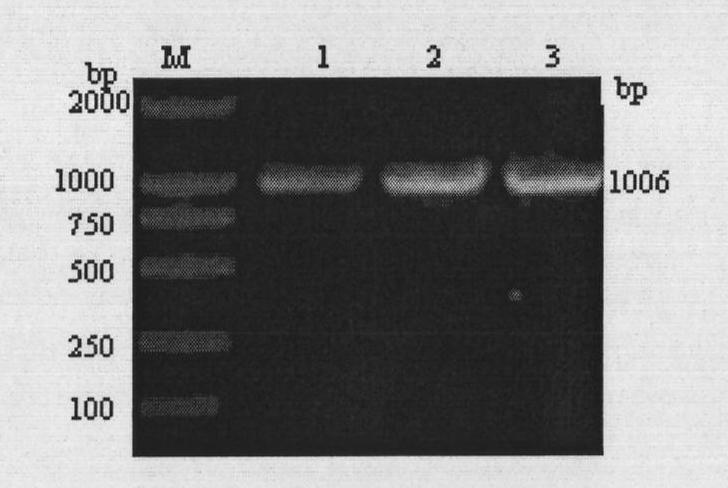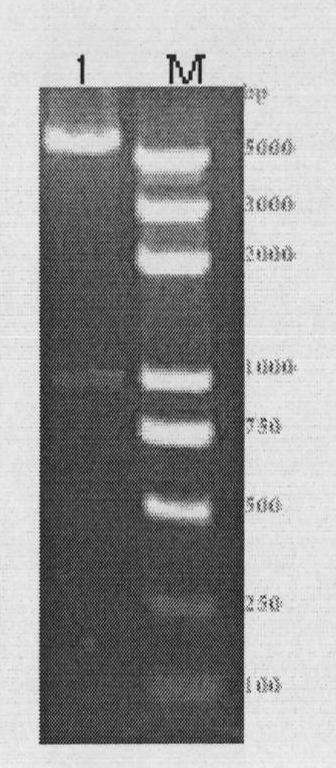Method for preparing swine novel gene BCL-GL polyclonal antibody
A polyclonal antibody, gene technology, applied in the field of bioengineering
- Summary
- Abstract
- Description
- Claims
- Application Information
AI Technical Summary
Problems solved by technology
Method used
Image
Examples
Embodiment 1
[0024] porcine BCL-G L Gene cloning:
[0025] human BCL-G L The gene cDNA sequence (accession number NM_138722) is the seed sequence, and the pig ESTs database is BLAST aligned and spliced in GenBank to obtain the pig BCL-G L cDNA sequence of the gene. Using this sequence as a reference, the upstream cloning primer (SEQ ID NO: 1) P1: 5'-TCCTTACTGCCACCTGAC-3', and the downstream cloning primer (SEQ ID NO: 2) P2: 5'-ATGCTGCCACATCCTATG-3' were designed.
[0026] Spleen tissue of 1-day-old Yorkshire pigs was collected, total RNA was extracted by TRIzol method, and total cDNA was obtained by reverse transcription with a reverse transcription kit. Using this as a template, PCR was performed, and porcine β-actin was used as an internal reference for PCR. The 25 μL reaction system includes: Premix Taq enzyme 12.5 μL, cDNA 1.25 μL, primer P1 0.5 μL, primer P2 0.5 μL, ddH 2 O 10.25 μL. The PCR parameters were 95°C for 5min, then 94°C for 1min, 53°C for 1min, 72°C for 1.5min, a t...
Embodiment 2
[0028] Prokaryotic expression vector pET32a-BCL-G L Construction: based on pMD19-BCL-G L Based on vector sequencing results, design primers for prokaryotic expression. Upstream primer (SEQ ID NO: 3) P3: 5'-AAGGATCCATGTGCACCACCAGC-3', downstream primer (SEQ ID NO: 4) P4: 5'-CCAAGCTTCAGTCTACTTCTTCATGGG-3'. Using the total cDNA as a template, PCR was performed with upstream and downstream prokaryotic expression primers. The 25 μL reaction system included: Premix Taq 12.5 μL, template 1.25 μL, primer P30.5 μL, primer P40.5 μL, ddH 2 O 10.25 μL. The PCR parameters were 95°C for 5min, then 94°C for 1min, 60°C for 1min, 72°C for 1.5min, a total of 30 cycles, and then 72°C for 10min. Amplify the target sequence. The target sequence and pET32-a vector were digested with BamH I and Hind III for 3 hours. Perform electrophoretic detection and gel recovery. The recovered product was ligated overnight at 16°C with T4 DNA ligase. The ligation product was transformed into DH5α competen...
Embodiment 3
[0030] Eukaryotic expression vector pEGFP-BCL-G L Construction of the eukaryotic expression vector: the construction method of the eukaryotic expression vector is basically the same as in Example 2, the upstream primer (SEQ ID NO: 5) P5: 5'-CAAAGCTTATATGTGCACCACCAGCACC-3', the downstream primer (SEQ ID NO: 6) P6: 5' - CCGGATCCTCAGTCTACTTCTTCATGGG-3'; the expression vector used was pEGFP-C1. The recombinant plasmid was named pEGFP-BCL-G L .
PUM
 Login to View More
Login to View More Abstract
Description
Claims
Application Information
 Login to View More
Login to View More - R&D
- Intellectual Property
- Life Sciences
- Materials
- Tech Scout
- Unparalleled Data Quality
- Higher Quality Content
- 60% Fewer Hallucinations
Browse by: Latest US Patents, China's latest patents, Technical Efficacy Thesaurus, Application Domain, Technology Topic, Popular Technical Reports.
© 2025 PatSnap. All rights reserved.Legal|Privacy policy|Modern Slavery Act Transparency Statement|Sitemap|About US| Contact US: help@patsnap.com



